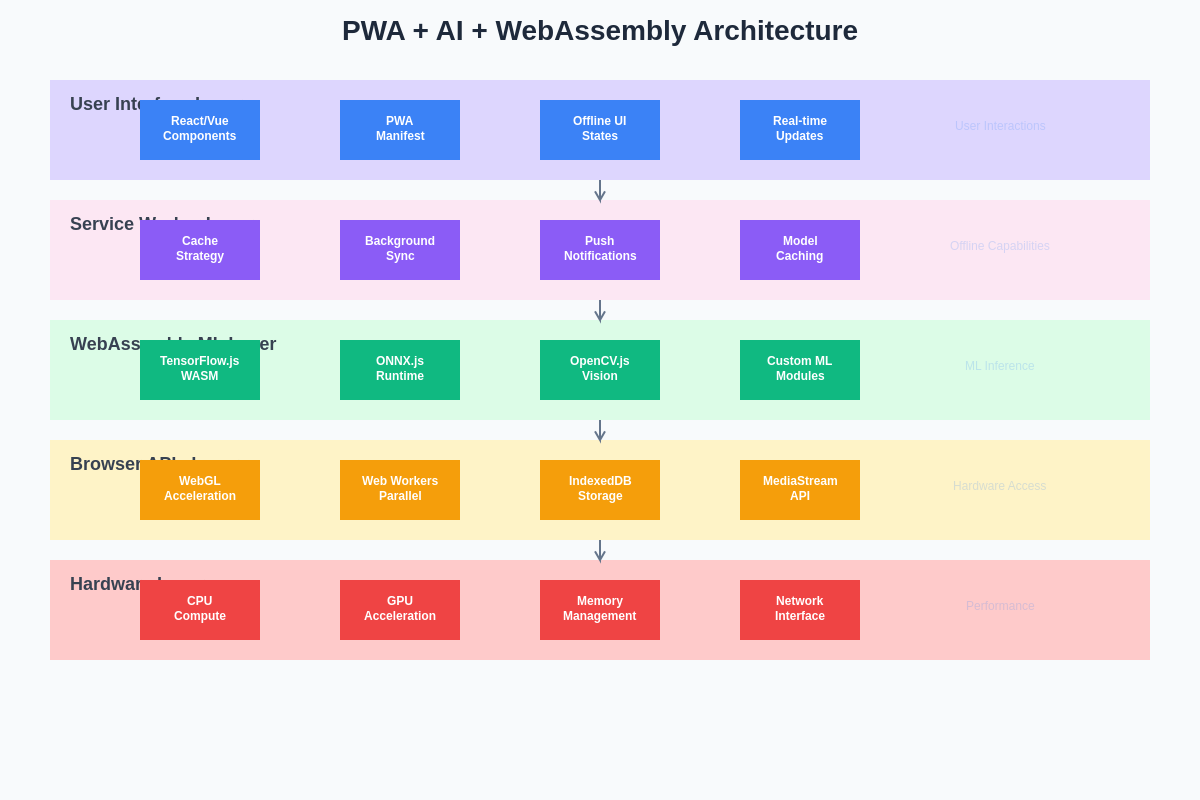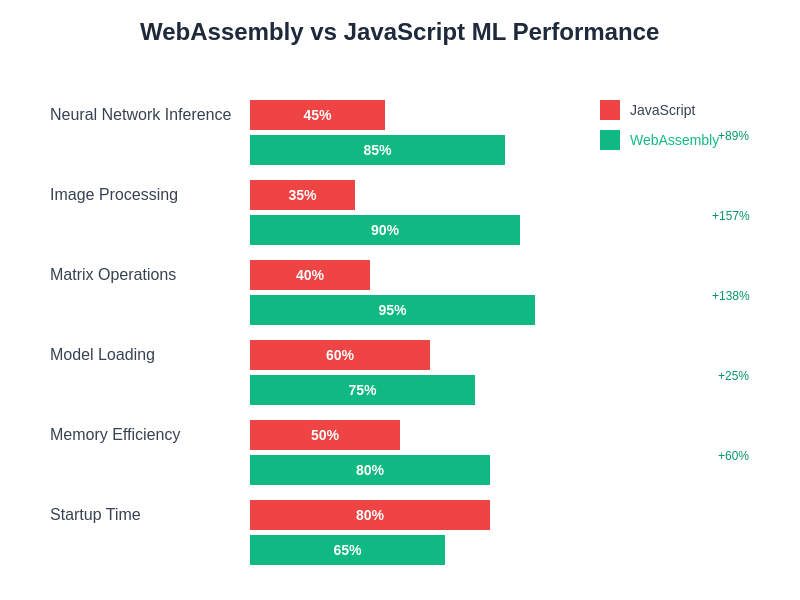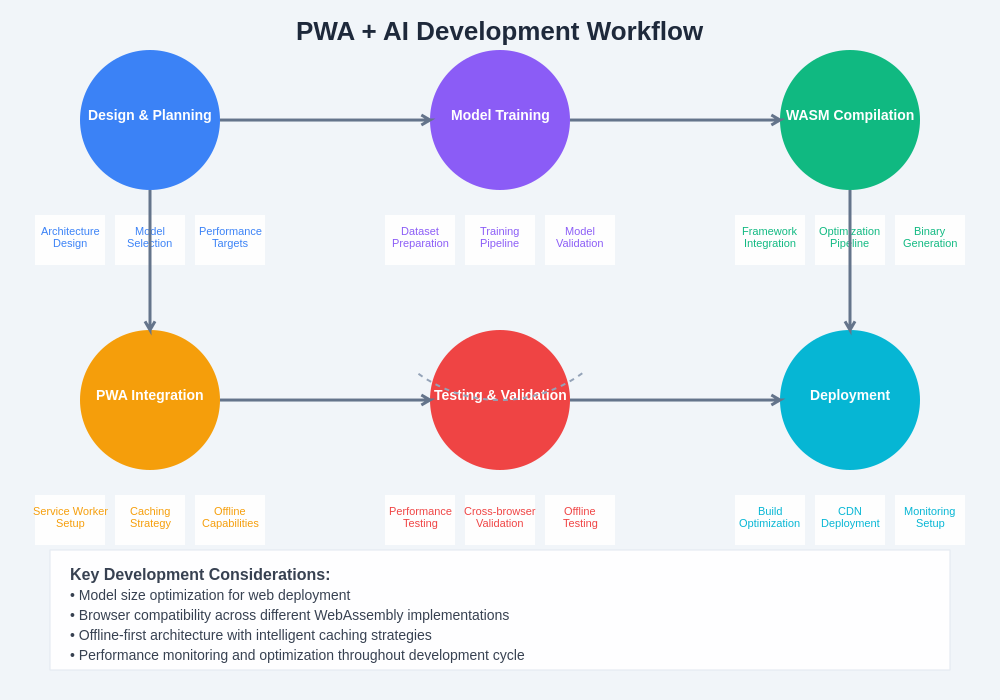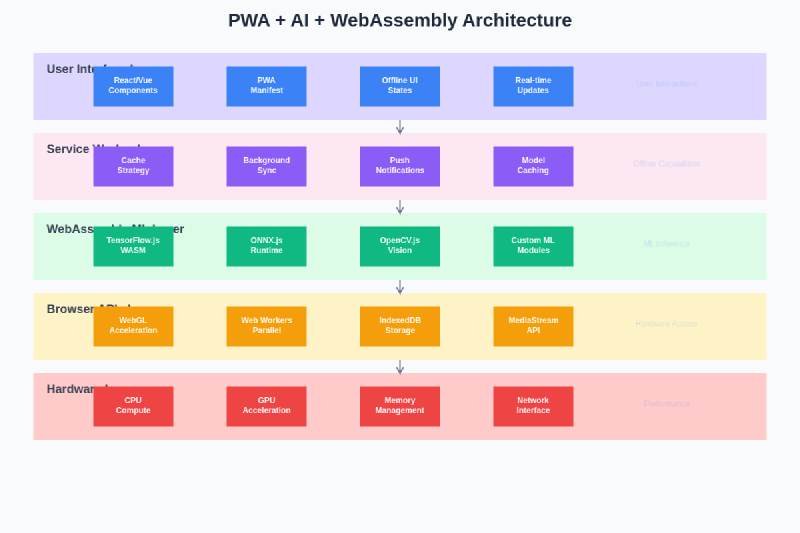The convergence of Progressive Web Apps, artificial intelligence, and WebAssembly has created an unprecedented opportunity for developers to build sophisticated machine learning applications that run entirely within the browser environment. This revolutionary combination enables the creation of powerful, offline-capable applications that deliver native-like performance while maintaining the accessibility and cross-platform compatibility that web technologies provide.
Stay updated with the latest AI and web development trends to understand how these cutting-edge technologies are reshaping the landscape of modern web applications. The integration of WebAssembly machine learning capabilities into Progressive Web Apps represents a fundamental shift in how we approach client-side computation and user experience design.
Understanding the WebAssembly Revolution
WebAssembly has emerged as a game-changing technology that bridges the performance gap between web applications and native software by providing a binary instruction format that enables near-native execution speeds within web browsers. When combined with machine learning frameworks and Progressive Web App capabilities, WebAssembly creates a powerful platform for deploying sophisticated AI models directly to end users without requiring server-side computation or constant internet connectivity.
The performance benefits of WebAssembly become particularly pronounced when dealing with computationally intensive machine learning operations such as neural network inference, image processing, and real-time data analysis. Unlike traditional JavaScript implementations that rely on interpretation and just-in-time compilation, WebAssembly modules execute at speeds that closely approach native application performance, making complex AI algorithms viable for browser-based deployment.
Progressive Web App Architecture for AI Applications
The architectural foundation of AI-powered Progressive Web Apps requires careful consideration of service worker implementation, caching strategies, and offline functionality to ensure seamless user experiences regardless of network connectivity. The service worker acts as a crucial intermediary that manages not only traditional web resources but also machine learning models, training data, and inference results, creating a comprehensive offline-first application architecture.
The integration of WebAssembly modules within the Progressive Web App framework involves sophisticated orchestration of multiple technologies working in harmony. The main application thread handles user interface interactions and high-level application logic, while WebAssembly workers execute machine learning computations in parallel, preventing blocking operations that could degrade user experience. This architectural separation ensures that complex AI operations never interfere with the responsive nature that users expect from modern web applications.

The layered architecture demonstrates how WebAssembly machine learning modules integrate seamlessly with Progressive Web App infrastructure, creating a robust foundation for sophisticated AI applications that maintain excellent performance characteristics across diverse hardware platforms and network conditions.
Experience advanced AI development with Claude to enhance your understanding of complex architectural patterns and implementation strategies for browser-based machine learning applications. The combination of expert guidance and practical implementation creates optimal outcomes for sophisticated web application development.
WebAssembly Machine Learning Frameworks
The ecosystem of WebAssembly-compatible machine learning frameworks has expanded rapidly, providing developers with multiple options for implementing AI capabilities within Progressive Web Apps. TensorFlow.js with WebAssembly backend support offers comprehensive neural network capabilities with optimized performance for browser environments, while ONNX.js provides cross-platform model compatibility that enables seamless deployment of models trained in various frameworks including PyTorch, scikit-learn, and TensorFlow.
The selection of appropriate machine learning frameworks depends heavily on specific use case requirements, model complexity, and performance constraints. TensorFlow.js excels in scenarios requiring comprehensive deep learning capabilities and extensive pre-trained model availability, while lighter-weight solutions like ML5.js provide simplified interfaces for common machine learning tasks such as image classification, pose estimation, and natural language processing without the overhead of full-featured frameworks.
Advanced WebAssembly implementations can leverage specialized libraries such as OpenCV.js for computer vision tasks, allowing developers to implement sophisticated image processing pipelines that execute entirely within the browser environment. These specialized libraries often provide significant performance advantages over JavaScript-only implementations while maintaining the security and sandboxing benefits inherent in web-based execution environments.
Model Optimization and Deployment Strategies
Successful deployment of machine learning models within Progressive Web Apps requires sophisticated optimization techniques that balance model accuracy with performance constraints imposed by browser environments. Model quantization techniques reduce memory usage and improve inference speed by converting floating-point weights to lower precision representations, while model pruning eliminates unnecessary connections to reduce overall model size without significantly impacting accuracy.
The deployment pipeline for WebAssembly machine learning models involves multiple stages of optimization and validation to ensure optimal performance across diverse hardware configurations. Model compilation tools convert trained neural networks into WebAssembly-compatible formats that can be efficiently executed within browser environments, while runtime optimization techniques such as memory pooling and computation batching further enhance performance characteristics.
Caching strategies for machine learning models within Progressive Web Apps require careful consideration of model size, update frequency, and storage constraints. Large models may be segmented into smaller chunks that can be loaded progressively based on application requirements, while frequently updated models require sophisticated versioning and cache invalidation mechanisms to ensure users always receive the most current model implementations.
Real-Time Data Processing and Inference
The implementation of real-time machine learning inference within Progressive Web Apps presents unique challenges related to data flow management, computational scheduling, and user interface responsiveness. WebAssembly workers provide the computational isolation necessary for complex machine learning operations while maintaining smooth user interface interactions through careful thread management and message passing protocols.
Streaming data processing capabilities enable Progressive Web Apps to handle continuous data inputs such as video streams, audio signals, and sensor data through sophisticated buffering and processing pipelines. The combination of WebAssembly performance characteristics and Progressive Web App offline capabilities creates opportunities for implementing real-time AI applications that function reliably regardless of network connectivity or server availability.

The quantitative analysis demonstrates the substantial performance improvements achieved through WebAssembly implementation compared to traditional JavaScript-based machine learning execution, particularly for computationally intensive operations such as neural network inference and image processing tasks.
Offline AI Capabilities and Data Synchronization
One of the most compelling advantages of WebAssembly machine learning within Progressive Web Apps lies in the ability to provide sophisticated AI functionality completely offline, enabling applications to deliver consistent user experiences regardless of network connectivity. The service worker architecture manages not only application resources but also machine learning models and training data, creating comprehensive offline-first AI applications that maintain full functionality during network outages.
Data synchronization strategies for offline-capable AI applications require sophisticated conflict resolution mechanisms and incremental update protocols to handle situations where local model predictions diverge from server-side computations. Background sync capabilities enable Progressive Web Apps to queue machine learning results for transmission when connectivity is restored, while maintaining local model accuracy through periodic synchronization with centralized model repositories.
The implementation of differential synchronization techniques allows Progressive Web Apps to efficiently update machine learning models by transmitting only model parameter changes rather than complete model files, significantly reducing bandwidth requirements and update latency. These optimization strategies become particularly important for applications targeting users in regions with limited connectivity or expensive data plans.
Enhance your research capabilities with Perplexity to stay current with rapidly evolving best practices in offline machine learning and Progressive Web App development. Comprehensive research capabilities ensure that implementation strategies remain aligned with current industry standards and emerging technologies.
Security and Privacy Considerations
The deployment of machine learning capabilities within Progressive Web Apps requires careful attention to security and privacy considerations, particularly when processing sensitive user data or implementing models that could be reverse-engineered by malicious actors. WebAssembly provides natural sandboxing capabilities that isolate machine learning computations from broader application contexts, but additional security measures may be necessary for applications handling sensitive information.
Client-side machine learning offers significant privacy advantages by eliminating the need to transmit user data to external servers for processing, but these benefits must be balanced against potential security vulnerabilities introduced by exposing machine learning models to client-side inspection. Obfuscation techniques and encrypted model storage can provide additional protection against model theft or unauthorized analysis.
The implementation of federated learning capabilities within Progressive Web Apps enables collaborative model training while preserving user privacy by keeping raw data on client devices. These advanced architectures allow applications to benefit from collective learning without exposing individual user information, creating privacy-preserving AI systems that respect user data sovereignty while delivering sophisticated functionality.
Performance Optimization and Scaling
Optimization of WebAssembly machine learning performance within Progressive Web Apps requires sophisticated understanding of browser execution environments, memory management strategies, and computational resource allocation. Memory pool management techniques prevent frequent allocation and deallocation operations that can degrade performance, while computation scheduling algorithms ensure optimal utilization of available processing resources across multiple concurrent operations.
The scaling characteristics of WebAssembly machine learning implementations depend heavily on model complexity, hardware capabilities, and application architecture decisions. Horizontal scaling through web worker parallelization can distribute computational load across multiple execution contexts, while vertical scaling through model optimization and algorithmic improvements enhances individual operation efficiency.
Advanced performance monitoring and profiling capabilities enable developers to identify performance bottlenecks and optimize critical code paths for maximum efficiency. These diagnostic tools become particularly important when deploying applications across diverse hardware configurations with varying computational capabilities and memory constraints.
Integration with Web Platform APIs
Modern Progressive Web Apps with AI capabilities can leverage extensive web platform APIs to create rich, integrated experiences that combine machine learning functionality with device capabilities such as cameras, microphones, sensors, and location services. The WebRTC API enables real-time communication features enhanced by machine learning processing, while the MediaStream API facilitates sophisticated audio and video analysis applications.
The integration of machine learning capabilities with Progressive Web App features such as push notifications, background sync, and offline storage creates comprehensive application experiences that rival native applications in functionality while maintaining web platform advantages such as instant deployment and cross-platform compatibility. These integrations require careful coordination between service workers, main application threads, and WebAssembly execution contexts.
Emerging web platform APIs such as the Web Neural Network API and WebGPU provide additional opportunities for optimizing machine learning performance within Progressive Web Apps. These specialized interfaces offer lower-level access to hardware acceleration capabilities while maintaining the security and compatibility characteristics that make web platforms attractive for application deployment.
Development Tools and Debugging Strategies
The development ecosystem for WebAssembly machine learning within Progressive Web Apps has evolved to include sophisticated toolchains that streamline the development, testing, and deployment process. Emscripten and other WebAssembly compilation tools provide optimizing compilers that convert machine learning libraries written in C++ and Rust into efficient WebAssembly modules, while debugging tools enable developers to diagnose performance issues and correctness problems.
Browser developer tools have expanded to include WebAssembly-specific debugging capabilities that allow developers to inspect WebAssembly module execution, analyze performance characteristics, and optimize computational efficiency. These tools become particularly important when working with complex machine learning pipelines that involve multiple WebAssembly modules working in coordination.
Testing strategies for AI-powered Progressive Web Apps require specialized approaches that validate not only traditional web application functionality but also machine learning model accuracy, performance characteristics, and offline behavior. Automated testing frameworks must account for the non-deterministic nature of some machine learning algorithms while ensuring consistent application behavior across diverse deployment environments.

The comprehensive development workflow illustrates the integration points between traditional Progressive Web App development practices and specialized WebAssembly machine learning implementation requirements, highlighting the additional considerations necessary for successful AI-powered web application development.
Future Trends and Emerging Technologies
The future evolution of Progressive Web Apps with AI capabilities will likely be shaped by emerging technologies such as WebGPU for hardware-accelerated machine learning, advanced WebAssembly features including threads and SIMD instructions, and standardized web APIs for neural network acceleration. These technological advances promise to further close the performance gap between web-based and native machine learning applications.
The standardization of web-based machine learning APIs through organizations such as the W3C will likely create more consistent development experiences and improved interoperability between different machine learning frameworks and browser implementations. These standardization efforts will reduce the complexity currently associated with cross-browser deployment of AI-powered Progressive Web Apps.
Edge computing integration with Progressive Web Apps will enable hybrid architectures where computationally intensive machine learning operations can be offloaded to nearby edge servers while maintaining offline fallback capabilities through local WebAssembly implementations. These hybrid approaches will optimize the balance between performance, privacy, and resource utilization based on current network conditions and computational requirements.
The continued advancement of WebAssembly capabilities, combined with improvements in browser-based machine learning frameworks, promises to unlock new categories of AI-powered web applications that were previously impossible or impractical to implement within browser environments. The democratization of sophisticated AI capabilities through web technologies will likely accelerate innovation and make advanced machine learning accessible to broader developer communities.
Disclaimer
This article is provided for informational purposes only and does not constitute professional advice regarding web development, machine learning implementation, or technology selection decisions. The rapidly evolving nature of web technologies, WebAssembly capabilities, and machine learning frameworks means that specific implementation details and best practices may change over time. Readers should conduct thorough research and testing before implementing production applications based on the concepts discussed in this article. Performance characteristics and compatibility may vary significantly across different browser implementations, hardware configurations, and use case requirements.
